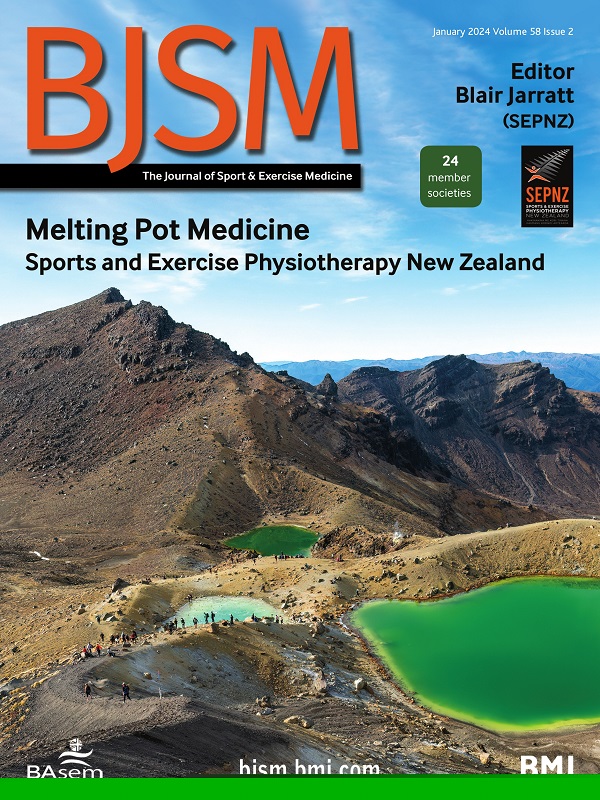将我们的注意力转向肩部不稳定康复的双重任务
IF 16.2
1区 医学
Q1 SPORT SCIENCES
引用次数: 0
摘要
肩关节脱臼是全球卫生系统面临的重大挑战。首次外伤性肩关节前脱位后的第一年复发率为39%,这是不可接受的,因此推进肩关节不稳定的治疗仍然至关重要目前,建议肩关节不稳定的非手术治疗应包括固定、运动范围练习、进行性力量、运动控制和力量发展速度、运动特点和心理准备这篇社论建议在典型的非手术管理中增加双重任务,作为提高其疗效的一种手段。双重任务,或“分散注意力”,描述了同时提供注意力或在两个或更多刺激之间切换的能力注意分割的有限资源理论认为,只有一个单一的注意资源池被分配到竞争刺激中,直接影响感觉运动整合和任务表现这支持了在康复中纳入双重任务的假设,即运动员在执行运动任务时更有能力同时关注环境中的刺激可能会改善结果,例如降低受伤的风险迄今为止,肩关节不稳定的传统非手术治疗已经建立在以力量康复为基础的基础上,其次是物理治疗中的临床推理,倾向于遵循生物医学框架,通过纠正干预来追求可观察到的客观缺陷这个物镜会假设肩部不稳定后的力量和功能以某种线性方式相关。然而,在肩部不稳的情况下,…本文章由计算机程序翻译,如有差异,请以英文原文为准。
Turning our attention towards dual tasking in shoulder instability rehabilitation
Shoulder dislocations present a significant challenge to the global health system. With an unacceptable recurrence rate of 39% in the first year after first-time traumatic anterior shoulder dislocation, advancing shoulder instability management remains crucial.1 Currently, it is recommended that non-surgical management of shoulder instability should include immobilisation, exercises focusing on range of motion, progressive strength, motor control and rate of force development, and sport-specifics and psychological readiness.2 This editorial proposes the addition of dual tasking to typical non-operative management as a means of enhancing its efficacy. Dual tasking, or ‘divided attention’, describes the ability to simultaneously provide attention to or switch between two or more stimuli.3 The limited resource theory of divided attention implies that only a single pool of attentional resources is divided among competing stimuli, directly influencing sensorimotor integration and task performance.3 This supports the inclusion of dual tasking in rehabilitation, with the hypothesis that athletes who are more competent at performing motor tasks while simultaneously attending to stimuli in their environment may have improved outcomes, such as reduced risk of injury.4 To date, the traditional non-surgical management of shoulder instability has been built around strength-based rehabilitation, secondary to clinical reasoning in physiotherapy tending to follow a biomedical framework of pursuing an observable objective deficit with a corrective intervention.5 This objective lens would assume that strength and function after shoulder instability are correlated in a somewhat linear fashion. However, in the case of shoulder instability, …
求助全文
通过发布文献求助,成功后即可免费获取论文全文。
去求助
来源期刊
CiteScore
27.10
自引率
4.90%
发文量
217
审稿时长
3-8 weeks
期刊介绍:
The British Journal of Sports Medicine (BJSM) is a dynamic platform that presents groundbreaking research, thought-provoking reviews, and meaningful discussions on sport and exercise medicine. Our focus encompasses various clinically-relevant aspects such as physiotherapy, physical therapy, and rehabilitation. With an aim to foster innovation, education, and knowledge translation, we strive to bridge the gap between research and practical implementation in the field. Our multi-media approach, including web, print, video, and audio resources, along with our active presence on social media, connects a global community of healthcare professionals dedicated to treating active individuals.

 求助内容:
求助内容: 应助结果提醒方式:
应助结果提醒方式:


